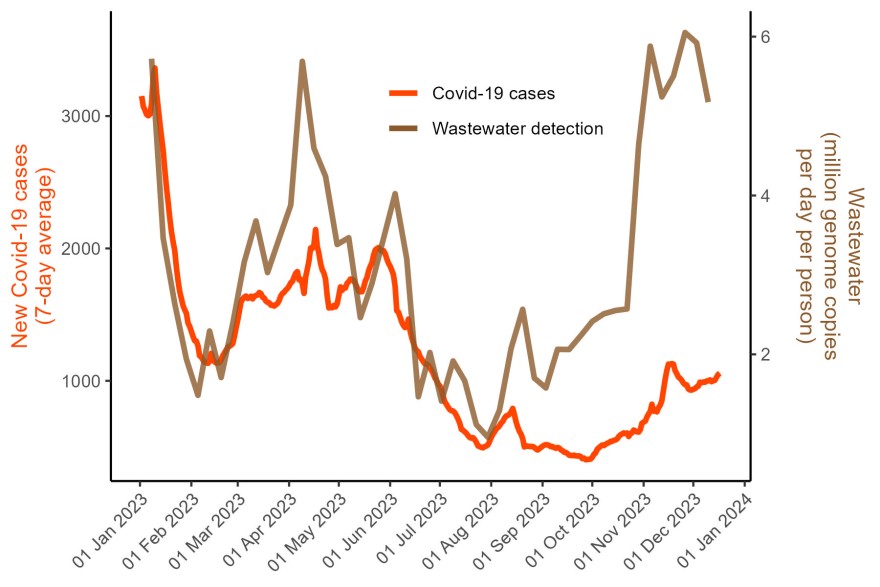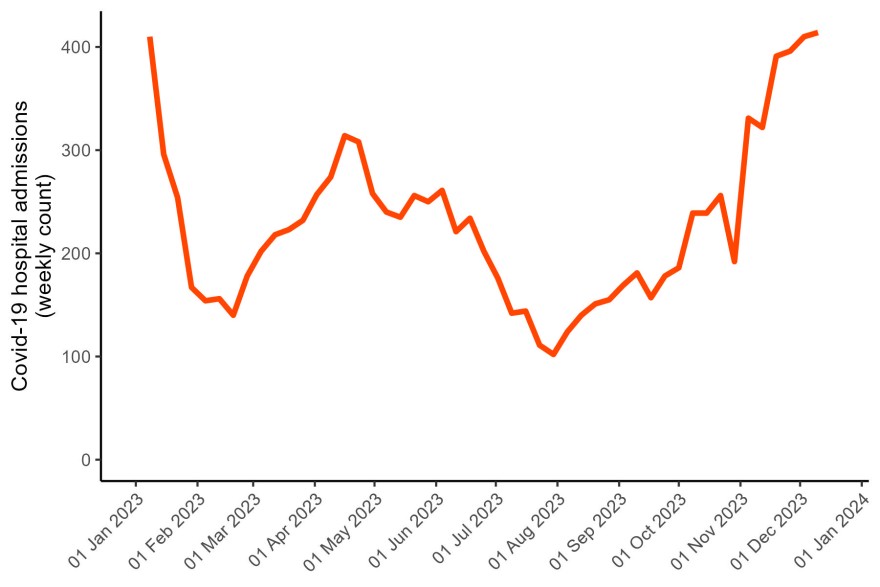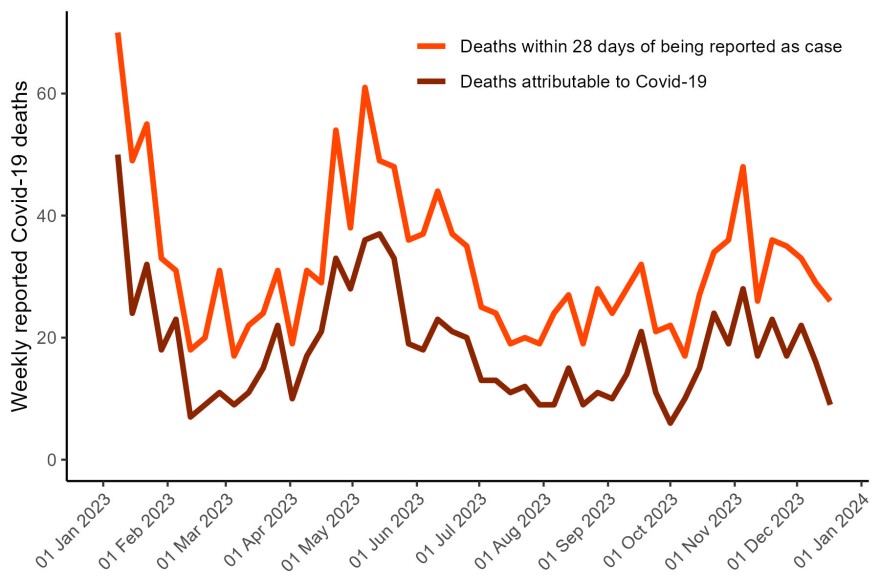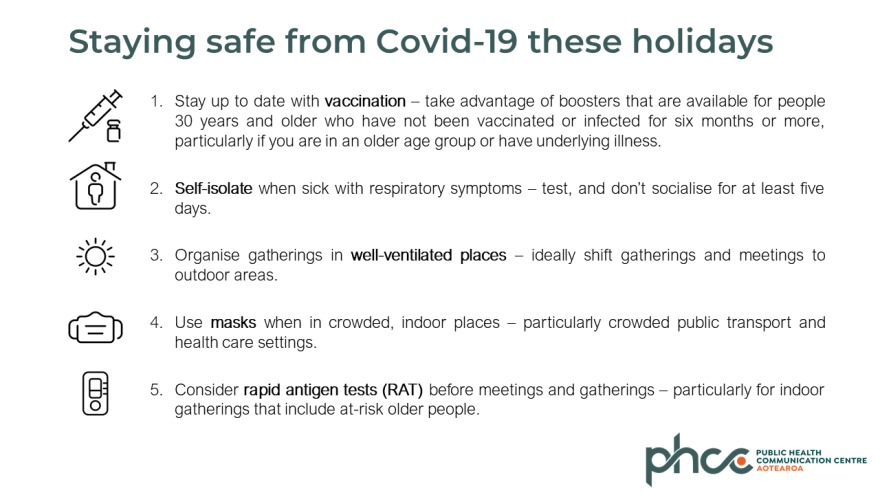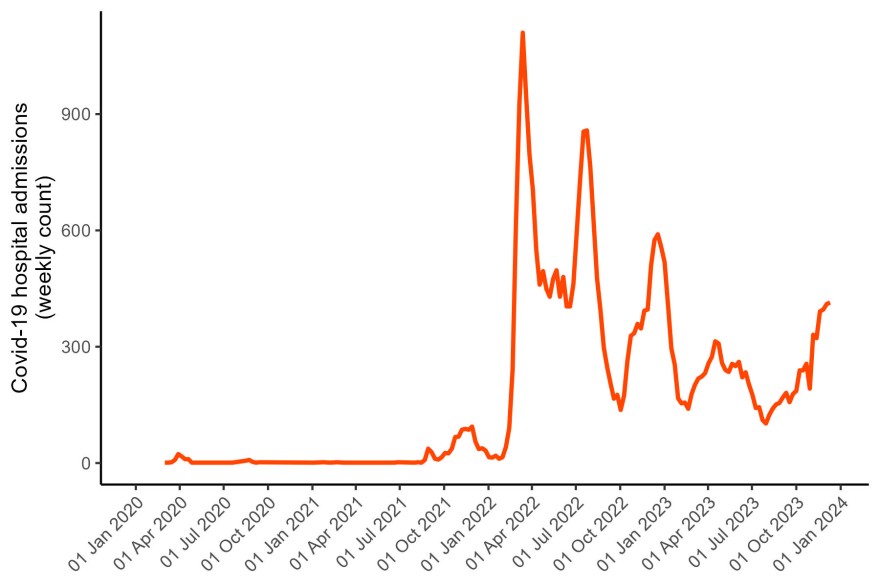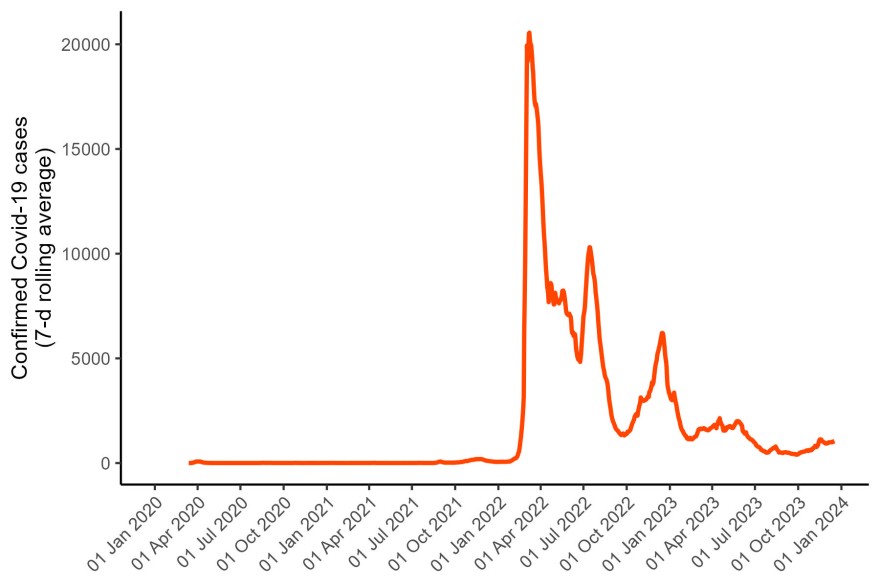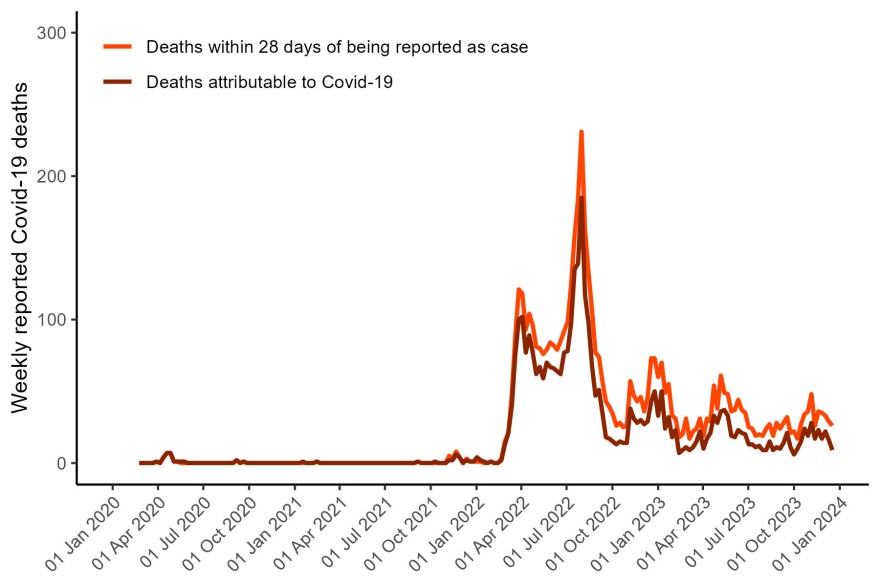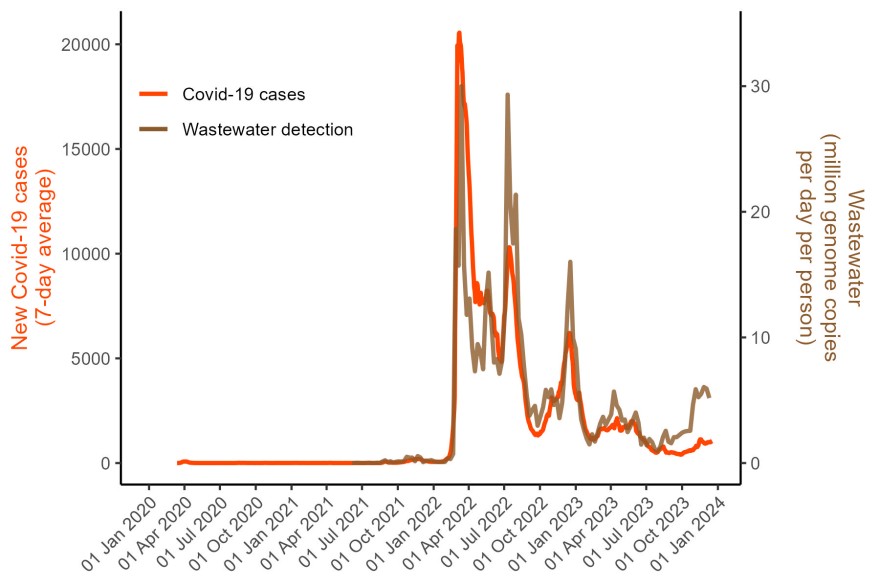Summary
Covid-19 is causing a large fifth pandemic wave in November-December 2023, as indicated by results of wastewater testing and hospitalisations. The net effect is that for the year 2023 as a whole, we can expect to see approximately 1,000 deaths and 12,000 hospitalisations, in addition to those affected in previous years. There will also be thousands of people disabled from long Covid during 2023. Drivers of these large waves of infection are likely to include waning immunity, continuing viral evolution, and relaxation of protective measures.
This pattern of recurring large waves of Covid-19 infection is a wake-up call for the NZ Government about the importance of a vigorous national strategy and programme to protect us from Covid-19 and other serious respiratory infections. This programme should include an updated Covid-19 vaccine, support for self-isolation, and a communication plan to maintain awareness about how to stay safe. Heading into Christmas, people can protect themselves and others by taking precautions such as vaccination, self-isolation when sick, organising well-ventilated gatherings, and using masks in crowded indoor spaces.
Unfortunately, Covid-19 is not going away and Aotearoa New Zealand (NZ) is currently experiencing its fifth wave of infections. This Briefing summarises the epidemiology and the implications of the continuing pandemic and the need for a vigorous national strategy and programme, as well as measures people can take to protect themselves and those around them.
Epidemiology of Covid-19
Surveillance data, particularly wastewater testing and hospitalisation data, show that the risk of infection in November-December 2023 is the highest it’s been since January this year.
The systems which give the most valid data on Covid-19 infection trends now are:
- Wastewater testing (Figure 1) as this doesn’t require action by members of the public. These data show the highest levels of detection of SARS-CoV-2 virus in sewage since January 2023.
- Hospitalisation data (Figure 2), as there is a relatively consistent threshold for admission to hospital. These data are showing that the current fifth wave has the highest level of seriously ill people being admitted to hospital since January 2023.
- Mortality data (Figure 3) are showing a smaller rise, though deaths lag other indicators by several weeks.
See the appendix for graphs showing the long-term epidemiology of Covid-19 in NZ.
Figure 1 Covid-19 wastewater detections (weekly) and new cases in NZ (7-day average), from 01 Jan to 10 Dec 2023. Sources: ESR,1 MoH2
Figure 2. Covid-19 hospitalisations in NZ, weekly total, from 01 Jan to 10 Dec 2023. Source: MoH2
Figure 3: Covid-19 deaths in NZ, weekly total, from 01 January to 17 Dec 2023. Source: MoH2
Impacts of Covid-19
The net effect of these waves of infection is that Aotearoa New Zealand is expecting a total of roughly 12,000 hospitalisations, and 1,000 deaths attributed to Covid-19 during 2023. These numbers are close to what trends suggested in the middle of the year.3 Added to numbers from previous years, this suggests a total of around 36,000 hospitalisations and more than 3,660 deaths from Covid-19 in NZ by the end of this year.
Covid-19 is a multisystem disease which commonly causes long-term health effects ranging from mild to severe that can persist for months or years.4,5,6 Long Covid risk applies to all age groups, and may ultimately be the largest health effect of Covid-19. The continuing large number of cases and hospitalisations is likely to result in an increase in long Covid cases.7
New Zealanders with severe long Covid are frequently unable to work and have health-related quality of life scores that are similar to people with multiple sclerosis. The phenomenon of working-age adults becoming disabled by long Covid raises concerns for low-income families8 and for school teachers,9 healthcare workers, and other occupations where Covid-19 infection rates have been particularly high in NZ.10 A recent study of NHS data available as a preprint reports that healthcare-associated costs for those with long Covid are significantly higher than controls and that costs have increased progressively from 2020-2023.
Influenza has exacted a high health impact in NZ for many years but Covid-19 has significantly greater acute and longer-term health impacts than influenza11 and is present all year round.
Drivers of the pandemic waves
The factors driving these waves are likely to include a mix of waning immunity, continuing Covid-19 virus evolution, and changing human behaviour (including relaxation of protective measures and some degree of response fatigue and complacency).
SARS-CoV-2 evolution and selection of new sub-variants that are better at escaping our immunity has been a feature of this pandemic from the beginning. Unlike 2022, the waves of infection in 2023 have been driven by an evolving ‘soup’ of subvariants with no single one that is dominant (Figures 4 and 5). Although virologists and evolutionary biologists were advising over two years ago that a new variant could cause a larger wave at any time, NZ policy has been based on an assumption that future waves would be smaller. This underestimate of risk has resulted in a lack of preparation for infection surges.
This virus still has the ability to surprise us with the emergence of highly divergent lineages. That was the case with BA.2.86 (Pirola) which was first detected in August 2023 and has now spread globally.12 A further evolved version, JN.113, with high immune evasion potential has been rapidly increasing in frequency worldwide and is now showing a modest increase in NZ as well (Figure 6).
Figure 5: Frequency of variants/lineages reported by ESR showing recent increase in BA.2.86 (mauve bars). From the COVID-19 Genomics Insights (CGI) Report #44, 8 December 202314
Figure 6. Covid-10 variants identified in NZ wastewater, showing the recent increase in BA.2.86 (mauve bars) and JN.1 (purple bars). Source: ESR dashboard1
Responding to Covid-19: The need for a national strategy
Effective pandemic control is a true public good, so governments have long recognised that they have a critical role in coordinating and resourcing this vital societal function.
We still need a health goal of minimising the number of Covid-19 infections and re-infections. Each infection carries the risk of serious illness (Figure 2) and death (Figure 3). In Taiwan, which has a very similar pandemic history to NZ, mortality risk is markedly higher for reinfections than initial infections.15 Many countries are observing an increase in excess mortality following the introduction of Covid-19, with the largest relative excess deaths in young and middle-aged adults, particularly from cardiovascular diseases.16
The NZ Government needs to introduce a comprehensive respiratory infection strategy.3 17
This strategy would apply a proactive and integrated approach to reduce NZ’s high burden of serious respiratory infections. Key aspects of the strategy are listed below (see appendix for more details):
- Choose and articulate an optimal and equitable response strategy.18
- Develop and implement an integrated respiratory infection programme to reduce disease burden.17 19-24
- Achieve and maintain high and equitable vaccine coverage for all at-risk groups.25
- Enhance health services capacity to manage respiratory infections.
- Improve public communication about respiratory infections.
- Improve surveillance and research to inform our response.
- Improve pandemic preparedness nationally and internationally.
Staying safe this Christmas
Socialising with whānau, friends and colleagues is a highlight of the holiday season and vital for our health, wellbeing, and enjoyment of life. At the same time, relatively small adjustments in how we do these things can help us enjoy the holiday period in relative safety.3 Practical advice can be found on the Unite against COVID-19 website. Key measures are summarised in the graphic below and described in the appendix.
Conclusion
Government has a critical role in coordinating and funding a national strategy and programme to mitigate the severe health and economic impacts of the continuing Covid-19 pandemic in NZ. These Government measures can support individuals taking action to protect themselves from infection and its consequences.
What is new in this Briefing
- NZ is in its fifth wave of Covid-19 infection which is larger than the fourth wave suggesting that this pandemic threat is continuing to evolve in unpredictable ways.
- The large number of hospitalisations being seen in November-December has serious health implications, including for a rise in long Covid.
Implications for public health policy and practice
- NZ needs a national respiratory infection strategy and programme to systematically reduce the health and economic impacts of Covid-19 and other respiratory infections.
- Individuals, families, and communities need to consider simple practical ways to reduce the risk of Covid-19 infection, particularly during periods of higher transmission that we are experiencing leading up to Christmas 2023.
Author details
Prof Michael Baker, Dr Julie Bennett, Dr John Kerr, Assoc Prof Amanda Kvalsvig
Appendix: Long-term surveillance data on Covid-19
Weekly Covid-19 hospitalisations 1 Mar 2020 to 17 Dec 2023, Source Ministry of Health2
Covid-19 cases 26 Feb 2020 to Dec 2023, Source Ministry of Health2
Covid-19 deaths 23 Feb 2020 to 17 Dec 2023, Source Ministry of Health2
Covid-19 waster testing results, compared with cases Jan 2020 to 10 Dec 2023, Source ESR1 and Ministry of Health2
Responding to Covid-19: The need for a national strategy
The NZ Government needs to introduce a comprehensive respiratory infection strategy.3 17 This strategy would apply a proactive and integrated approach to reduce NZ’s high burden of serious respiratory infections. Key aspects of the strategy would include:
- Choose and articulate an optimal and equitable response strategy: Given the large health impact of Covid-19 a continuing mitigation strategy is justified. There are large efficiency gains in having an integrated strategy that includes influenza and other seasonal respiratory infections.
- Develop and implement an integrated respiratory infection programme to reduce disease burden, including:
- Support for self-isolation of infected cases, such as improve sick leave entitlement.
- Improve indoor air to reduce transmission, notably improved indoor air quality standards.
- Maintain mask use in high-risk indoor environments such as health care settings.23
- Implement strategies to limit transmission in shared environments like schools.19
- Achieve and maintain high and equitable vaccine coverage for all at-risk groups:
- Continue to refine the Covid-19 vaccine schedule, notably introduction of new vaccines better adapted to currently circulating strains such XBB.1.5 vaccines as recommended by WHO.
- Continue to efforts to achieve high and equitable vaccine coverage.
- Enhance health services capacity to manage respiratory infections:
- Review and enhance equitable delivery of essential respiratory infection management interventions such as antivirals (notably Paxlovid).
- Improve public communication about respiratory infections:
- Provide effective and culturally appropriate communication for informing the public about increasing infection numbers and about actions that they need to take. These systems would include resourcing community-led initiatives by Māori and Pacific providers to embed and extend the public health information services they provided during the early stages of the Covid-19 pandemic.26
- Improve surveillance and research to inform our response:
- Continue to improve current surveillance systems, including filling important gaps such as sentinel surveillance and surveillance of long Covid.
- Develop a research agenda to fill key gaps in knowledge about COVID-19 and its management, including analysis of the cost-effectiveness of interventions (eg, vaccination, ventilation upgrades) and identifying ways of improving the equity and sustainability of the response to respiratory infections.
- Improve pandemic preparedness nationally and internationally:
- These measures against current respiratory infections also protect against new emerging pathogens before vaccines are available. The proposed integrated system would be a cornerstone of NZ’s future pandemic preparedness.
Staying safe this Christmas
Socialising with whānau, friends and colleagues is a highlight of the holiday season and vital for our health, wellbeing, and enjoyment of life. At the same time, relatively small adjustments in how we do these things can help us enjoy the holiday period in relative safety.3 Practical advice can be found on the Unite against COVID-19 website. For people wanting to minimise the impact of Covid-19 over the Christmas period, there are a familiar set of precautions:
- Stay up to date with vaccination – take advantage of boosters that are available for people 30 years and older who have not been vaccinated or infected for six months or more, particularly if you are in an older age group or have underlying illness.
- Self-isolate when sick with respiratory symptoms – test, and don’t socialise for at least five days.
- Organise gatherings in well-ventilated places – ideally shift gatherings and meetings to outdoor areas.
- Use masks when in crowded, indoor places – particularly crowded public transport and health care settings.
- Consider rapid antigen tests (RAT) before meetings and gatherings – particularly for indoor gatherings that include at-risk older people


